Things are looking pretty positive for the US economy – economists generally expect a slow Q1 GDP but that is in the past – look only forward! Cold weather is behind us, a strong dollar is keeping inflation low and low unemployment painted a pretty picture. The biggest US news was mostly in commodities – fracking regulation, oil deals with Iran, cheap(ish) gasoline fueling more miles on the road and dovish Federal Reserve comments hinting at delays of interest rate increases partially due to low inflation. Europe is vacuuming up government debt under its new Q€ program while at the same time trying to keep the crisis in the Ukraine from reigniting. An Iran nuclear deal would be opportune to offset any negative economic fallout over Greece (whose debt is still being negotiated – we know that they cannot pay but the question is who has to take the loss and when). Sure China is slowing but that is good news since the central government will cover the debts of the local governments and keep the stimulus flowing… just ignore the margin debt on the way up! Oil is still the geopolitical center with the fighting in Iraq moving slowly in the direction against ISIS. Very slowly. The same cannot be said for Yemen. Libya is looking to restart oil exports although its political stability is questionable. Finally the weather is too dry here in the US (particularly in California!) but the mid-west is due for some rain and the crops are doing quite well in South America and Europe. All-in-all, the world stumbled forward another month by kicking the can down the road.
Don’t Stop Thinking About Tomorrow: February’s job numbers came in strong at +295,000 and the unemployment rate fell to 5.5%. March, on the other hand, came in weak at +126,000 but the unemployment stayed at the low 5.5% level. SouthBay Research (who was the lowest of the Bloomberg Survey of economists for the March payrolls) noted that the government’s changes in the seasonal adjustments were the largest factor behind the lower numbers. They, like many others, are expecting a rebound in April on better weather and west coast ports back in operation. Final Q4 GDP came in at +2.2%, down slightly from the +2.4% expected, though full year 2014 came in at +2.4%. Household consumption, the largest component at 70%, was up +2.5% for the full year, the most since 2006. In the negative camp, factory production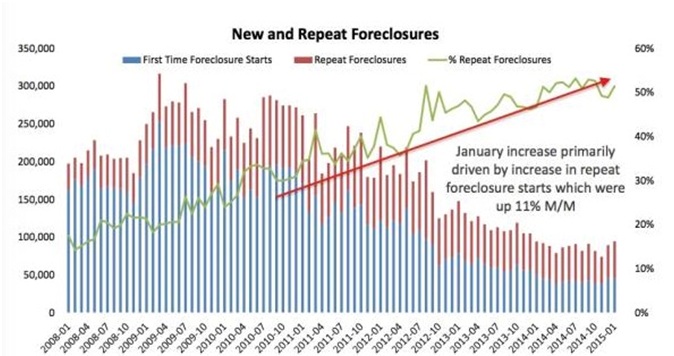 fell in February for the third consecutive month, albeit slightly at -0.2%. The strikes at the west coast docks disrupted many imported supplies while exports were hampered by a lackluster global economy and stronger US dollar. Industrial Production, which is manufacturing plus mining and power production, was up, again ever-so-slightly at +0.1%. On the other hand, Durable Goods orders unexpectedly fell in February, at minus 1.4%. Home sales were mixed as Existing Home Sales were up less than expected at +1.2% in February but New Home Sales jumped +7.8%. Foreclosures appear to have bottomed out though interestingly repeat foreclosures still make up half. In terms of household debt, while mortgage debt grew the strongest in Q4 2014, student debt was right behind it. While mortgage
fell in February for the third consecutive month, albeit slightly at -0.2%. The strikes at the west coast docks disrupted many imported supplies while exports were hampered by a lackluster global economy and stronger US dollar. Industrial Production, which is manufacturing plus mining and power production, was up, again ever-so-slightly at +0.1%. On the other hand, Durable Goods orders unexpectedly fell in February, at minus 1.4%. Home sales were mixed as Existing Home Sales were up less than expected at +1.2% in February but New Home Sales jumped +7.8%. Foreclosures appear to have bottomed out though interestingly repeat foreclosures still make up half. In terms of household debt, while mortgage debt grew the strongest in Q4 2014, student debt was right behind it. While mortgage 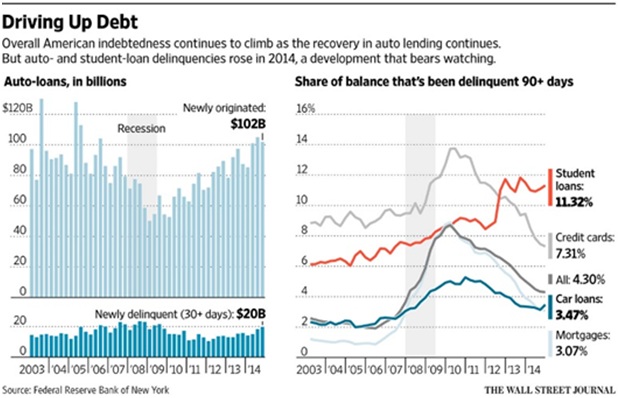 delinquencies have overall bottomed out as per the above chart, student loan and auto loan delinquencies are stagnating at high levels or slightly worsening (depending on your point of view – see right). One can only have sympathy for this recent graduate’s statement on the top of the mortar cap:
delinquencies have overall bottomed out as per the above chart, student loan and auto loan delinquencies are stagnating at high levels or slightly worsening (depending on your point of view – see right). One can only have sympathy for this recent graduate’s statement on the top of the mortar cap:
In terms of people’s wallets, however, drivers did respond to lower prices as gasoline consumption totaled 8.7 million barrels per day in January, a +6.2% increase from a year ago and the highest for a January since the financial recession of 2008. A +4.9% increase in vehicle miles driven during that same time period confirmed that trend.
The question is how Yellen and the Fed will react to this mish-mash of data. At the latest meeting and in the subsequent press releases, the poll of the members of their estimates of when rates will go up indicated a delay to increases, most likely past the June timing the market had in mind and towards September. The graph below of the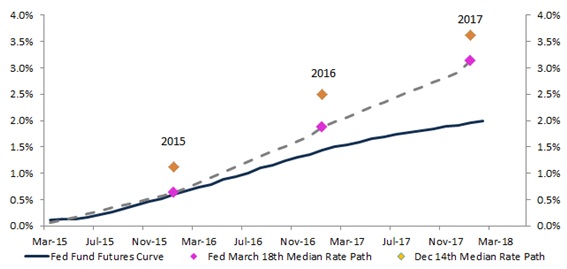 Federal Reserve members’ expectations of future short-term rates is shifted down – falling from the yellow dots estimated three months ago to the pink dots from the last meeting. Traders in the markets (the blue line) are predicting further declines. Either the economy is not very strong as it needs to be in emergency ultra-low rate mode for longer, or the Federal Reserve is playing political games by maximizing the opportunity for federal, state and local governments to issue debt at ultra-low rates while at the same time trying to stoke inflation to minimize the real value of such debt. Note that given the negative rates in Europe, the Federal Reserve has plenty of room to raise rates (at least optically) or start decreasing its balance sheet by letting debt mature without reinvestment because the rate differential is naturally attracting US debt purchases by foreigners. A stronger US dollar fueled by those outside purchases would compound such returns.
Federal Reserve members’ expectations of future short-term rates is shifted down – falling from the yellow dots estimated three months ago to the pink dots from the last meeting. Traders in the markets (the blue line) are predicting further declines. Either the economy is not very strong as it needs to be in emergency ultra-low rate mode for longer, or the Federal Reserve is playing political games by maximizing the opportunity for federal, state and local governments to issue debt at ultra-low rates while at the same time trying to stoke inflation to minimize the real value of such debt. Note that given the negative rates in Europe, the Federal Reserve has plenty of room to raise rates (at least optically) or start decreasing its balance sheet by letting debt mature without reinvestment because the rate differential is naturally attracting US debt purchases by foreigners. A stronger US dollar fueled by those outside purchases would compound such returns.
There is risk of course – though not necessarily for the US. Emerging markets have doubled their borrowing in US dollars over the last five years to $4.5 trillion. They face cash crunches if their exports do not generate dollars – recall the EM bond and currency crisis in 1997. Now Turkey (1/3rd of its government debt in US dollars), Indonesia (45% of its government debt) and others with high current account deficits in US dollars (e.g., Brazil and South Africa) will be under greater pressure economically. Even China could face pressures as Chinese firms have about 25% of their debt denominated in US dollars but US dollars account for only 8.5% of earnings (obviously such a mismatch at the aggregate level may not be true for any particular company). US monetary actions may precipitate a crisis but this country is not the weakest link in the global economy.
“Mission Accomplished:” While more of an interpretation rather than a direct translation, Draghi in March called the end of the Eurozone crisis with, naturally, the 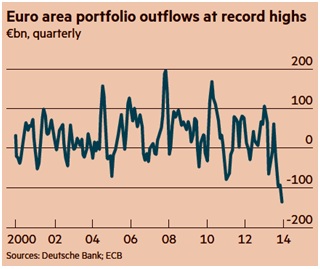 help of his Q€ program. Interestingly, he trumped his success on March 6th, which was before Q€ was set to begin on the 10th. More precisely, he was taking credit for his Q€ announcement causing lower interest rates before the program begun. Of course, traders were front-running his purchase plans – they were acquiring bonds early to enjoy capital gains as the ECB stepped in afterwards to buy, pushing the price up even higher. By the end of March, Draghi had purchased €47.4 billion with 25% of the total from Germany (yes, the country with negative yields up to seven years
help of his Q€ program. Interestingly, he trumped his success on March 6th, which was before Q€ was set to begin on the 10th. More precisely, he was taking credit for his Q€ announcement causing lower interest rates before the program begun. Of course, traders were front-running his purchase plans – they were acquiring bonds early to enjoy capital gains as the ECB stepped in afterwards to buy, pushing the price up even higher. By the end of March, Draghi had purchased €47.4 billion with 25% of the total from Germany (yes, the country with negative yields up to seven years maturity). We note that no Greek or Cypriot debt was purchased. As the FT graphic to the right shows, of the €720 billion that the ECB is expected to spend in 2015, it will absorb all of the debt expected to be issued (€306 billion) and then have to buy an additional €414 billion of existing debt. When investors sell the €414 billion, it will either have to go into equities (Portuguese, German and Italian equities were up over 20% in Q1 in Euro terms) or non-European investments – which may be already occurring as indicated in the FT graphic on the left. While it is too early to call a trend, there could be further money flow out of the Eurozone. Will the US be a net recipient of these funds? Makes sense to me. Also, American companies are borrowing in Euros in record amounts – already €33 billion in 2015 which is three times of what was raised last year during the same period. A weaker Euro will make repaying those debts more attractive. Supporting Draghi is the OECD, which has already increased the Eurozone GDP growth projections for 2015 and 2016 by +0.3% – not a lot but when the original projection was for +1.1% and +1.7% respectively, it is a sizable percentage increase. I wonder if the ECB’s buying of almost €6 billion of supernational debt (i.e., the debt of the World Bank, IMF, etc.) of the OECD’s associated organizations played a part in this favorable review. We do note that the ECB has projected double-digit Eurozone unemployment at the end of its Q€ program – a move from 11.2% currently to 10% in 2017. An improvement but hard to be sure of given the competition from Asia and the Americas. As I said earlier, the underlying (likely faulty) assumption is “Mission Accomplished.”
maturity). We note that no Greek or Cypriot debt was purchased. As the FT graphic to the right shows, of the €720 billion that the ECB is expected to spend in 2015, it will absorb all of the debt expected to be issued (€306 billion) and then have to buy an additional €414 billion of existing debt. When investors sell the €414 billion, it will either have to go into equities (Portuguese, German and Italian equities were up over 20% in Q1 in Euro terms) or non-European investments – which may be already occurring as indicated in the FT graphic on the left. While it is too early to call a trend, there could be further money flow out of the Eurozone. Will the US be a net recipient of these funds? Makes sense to me. Also, American companies are borrowing in Euros in record amounts – already €33 billion in 2015 which is three times of what was raised last year during the same period. A weaker Euro will make repaying those debts more attractive. Supporting Draghi is the OECD, which has already increased the Eurozone GDP growth projections for 2015 and 2016 by +0.3% – not a lot but when the original projection was for +1.1% and +1.7% respectively, it is a sizable percentage increase. I wonder if the ECB’s buying of almost €6 billion of supernational debt (i.e., the debt of the World Bank, IMF, etc.) of the OECD’s associated organizations played a part in this favorable review. We do note that the ECB has projected double-digit Eurozone unemployment at the end of its Q€ program – a move from 11.2% currently to 10% in 2017. An improvement but hard to be sure of given the competition from Asia and the Americas. As I said earlier, the underlying (likely faulty) assumption is “Mission Accomplished.”
Two areas which most certainly are not “mission accomplished” are the Greece debt negotiations and the debt write-downs associated with the collapse of the Austrian bank holding company of Heta, which held the distressed assets of the failed Austrian bank Hypo Alpe Adria (HAA). HAA was the Austrian subsidiary of the German bank BayernLB which collapsed due to bad loans made to Greece and other Balkan countries during the financial crisis in 2008. When HAA became insolvent and was reformed into Heta, the Austrian regional government of Carinthia gave the new bank a guarantee. Carinthia has a total annual budget of €2.4 billion but the senior debt that it was guaranteeing has a face value of over €10 billion. Unfortunately over the last six years, the accumulated losses of 40% or so on Heta’s bad debts overwhelmed Carinthia’s financial capacity (since 40% of more than €10 billion is almost twice as large as the annual budget!). Therefore, Carinthia backed away from the guarantee to try to force Heta’s senior lenders to take the loss. So much for the guarantee. Who was hit? Small German bank DuesselHyp went under by owning €348 million of Heta debt. The well-known German bank Commerzbank as well as the regional German bank NordLB also each have €400 million exposures. Dexia (the bankrupt Belgium bank which has graced these pages a few years ago) has €350 million at risk. However, the biggest hit will be an additional impairment of €1 billion to BayernLB to bring their write-down of their Heta investment to €1.3 billion. In short, Fitch estimates as much as 10% of German bank profits for 2015 will be lost. So much for “guaranteed” senior debt! Let the lawsuits begin!
Meanwhile, Greece and the troika are still negotiating the debt situation after an agreement in March to keep negotiating. There are still bills to pay, however (for example, €1.7 billion was paid at the end of March for civil servant wages and pensions and on April 9th €450 million was due the IMF). The government still is rolling over short-term treasury bills but as those amounts increase (they are over €1.4 billion now and due on April 14th), then at some point the market will not accept them at any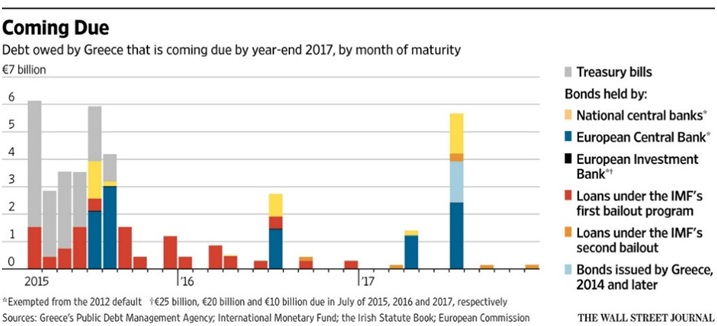 interest rate. Raiding the social security fund will buy some time, but very soon one should expect that the government will have to cut salaries and take other drastic steps such as renege on all the promises of free electricity and so on that got Syriza elected. Or they could default and leave the Euro. Even if they reach a settlement, it would just add €30 to €50 billion to a debt level that Greece cannot service anyway. I do not think that April will see an end to this as it is too soon – therefore May or June when some larger repayments are due (€6 billion and €4 billion, respectively) is a more likely tipping point. Stay tuned.
interest rate. Raiding the social security fund will buy some time, but very soon one should expect that the government will have to cut salaries and take other drastic steps such as renege on all the promises of free electricity and so on that got Syriza elected. Or they could default and leave the Euro. Even if they reach a settlement, it would just add €30 to €50 billion to a debt level that Greece cannot service anyway. I do not think that April will see an end to this as it is too soon – therefore May or June when some larger repayments are due (€6 billion and €4 billion, respectively) is a more likely tipping point. Stay tuned.
Ukraine has been relatively quiet since the cease-fire –shots are still being fired by the Russia-backed rebels but no real exchange of territory. We should have to wait a little after the spring thaws to see if the fighting will start up again in earnest. Can Putin resist the temptation? On the other hand, will he meddle in Greece? Not like he has €340 billion to throw around.
Slow, Slow; Stimulate, Stimulate! With Chinese GDP growth expectations for 2015 running at +6.8% per the IMF, the stimulus chatter is intensifying. Both Premier Li as well as the head of the central bank commented in March that the rate of growth has tumbled “a bit too much” and that stimulus was in the cards. A challenge is the country’s total debt has already quadrupled in seven years from $7 trillion to $28 trillion, with a total (government plus private) debt-to-GDP ratio of 282% per a new McKinsey report – a higher ratio than for the US, Germany or Japan. The central government spurred local governments to roll over their older debts into new bonds at lower rates, but that will cover only $240 billion of notional value – 5% of the roughly $5 trillion total muni debt (N.B. a very rough number). There were some marginal announcements – i.e., a lowering of the down payment for first time homebuyers (from 30% to 20%) and second homes (from 60% to 40%). Yes the housing sector is very important, but it seems that this would have a limited long-term effect. However, with a twelve month drop of -5.7% in housing prices for February (worse than January’s -5.1%), something must be done. The rest of the economy is not picking up the slack: factory output for the year ending February was +6.8% but that missed expectations of +7.8%, retail sales likewise missed (+10.7% versus +11.7%), power generation up only +1.9% (versus +3.2% for 2014 which was the worst of the last fifteen years), rail freight traffic down -9.1% and Purchasing Manager Index (PMI) came in at a contraction instead of an expansion (49.2 versus 50.5 expected with 50 for no growth). PMI’s New Orders was the weakest link at 49.3 which does not bode well for April.
Also concerning is the quadrupling of stock market margin debt over the last twelve months on the Shanghai Stock Exchange to $161 billion to put the total Chinese margin debt at $242 billion. To compare to the New York Stock Exchange, there is $465 billion in margin debt but against four times the market size. With more than two-thirds of new investors having never attended and/or graduated from high school, their inexperience plus this extreme leverage coupled with the economic slowdown outlined above could put the 86% twelve-month stock market gain at risk, don’t you think?
Japan is still struggling as its factory output fell -3.4% year-on-year in February when a decline of -1.9% was expected while its PMI came in at a marginal expansion of 50.4 versus the 52.0 expected. However, the embrace of risk is in full force with Japan’s social security fund about 1/6th the way complete in its realignment program of selling domestic bonds and buying domestic stocks and foreign stocks and bonds. To recall, the allocation of domestic bonds is going from 60% to 35% with half the difference going into domestic stocks, and the other half into international stocks and bonds. At the current rate, the transition should be complete by Q1 2016. I wonder if they are buying any Greek debt. Finally, South Korea became the latest country to deal with a debt crisis with a surprise lowering of rates by its central bank. With household debt at 160% (which is amongst the highest internationally), an aging population and 74% of mortgages interest only, the time bomb is ticking away there too.
Still Gushing? Crude oil led the macro news in March as an Iran deal outline came together at least close enough for each side to agree (perhaps only temporarily) on allowing Iran to continue nuclear research and maintain a limited nuclear capacity in exchange for a reduction of sanctions. There are still a lot of pending details and ultimate ratification by the many involved nations so it can still collapse. However, there is a break in the tension for three months until we again are swept up in this political drama. My feeling is that there will be a final deal but a lot of angst between now and then. Of course, the amount of oil that could be unleashed upon the world is estimated by the EIA to hit oil prices by as much as $15 per barrel given an expected 25% boost of output as well as an estimated 30 million barrels already in storage, ready to ship. We do not expect to see this until late 2015 or early 2016, however. More bearish news in March included the decline in US rigs has started to halt, Saudi Arabia still plans to produce at record levels (10.3 million barrels per day), Iraq’s army and Shi’ite militias pushed ISIS out of the strategic city of Tikrit, two tankers in war-torn Libya loaded oil for export to Italy, Russian oil output in March hit a post-Soviet high (10.7 million barrels per day), a relatively peaceful election in Nigeria which was won by the opposition party (and former dictator) and US oil companies raised $13 billion in equity and debt year-to-date to keep them going through these low oil prices. On the bullish side, fighting in Yemen between Sunnis and Shi’ites could expand to draw in Iran and Saudi Arabia in direct conflict, Obama is introducing rules to further regulate fracking on federal land (which supplies 11% of US crude oil and natural gas) and Mexico’s Pemex suffered from an explosion at an oil platform in the Gulf of Mexico, killing four workers.
The El Niño formation in the Pacific as well as volcano activity in the North Atlantic should bring rain to the Midwest and South Midwest as spring progresses. While it will do nothing for drought-ravaged California, row crops should benefit from more normal rainfall and growing season. Large harvests are underway in South America, with Argentina and Brazil leading. On the other hand, the ISIS-controlled regions of Syria and Iraq as well as north Iran are starting a multi-year drying pattern that lasted two decades during the last one in the 1970s. With between double to triple the population living in those zones now versus 1975, there could be heightened conflict over water (recall that the Mosul dam was subject to heavy fighting between ISIS and the Iraqi army, and still needs major maintenance to remain viable). Finally, we note that the World Health Organization of the UN declared glyphosate (the weed-killer used by Monsanto’s ubiquitous Round-Up) a probable carcinogen. It will be interesting to see whether the herbicide will be broadly banned given the large number of percentage of crops where it is used – i.e., 90% of the US soybeans and 70% of US corn and cotton are genetically-engineered to survive its spray.
Best of investing!
David Burkart, CFA
April 10, 2015
Additional information sources: Bloomberg, The Economist, Financial Times, New York Times, Politico, South Bay Research, Wall Street Journal and Zerohedge.
